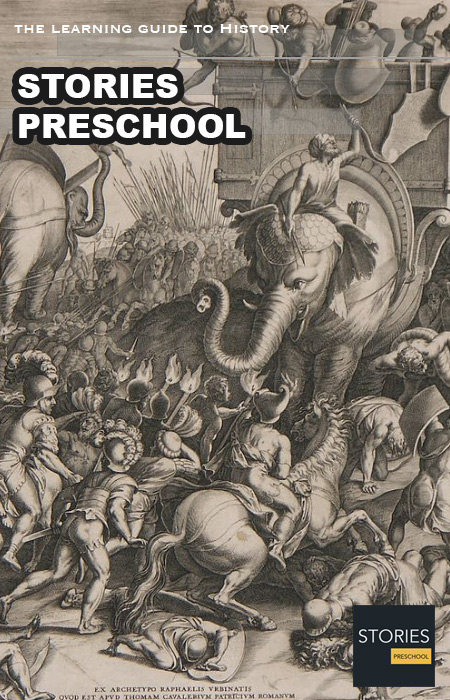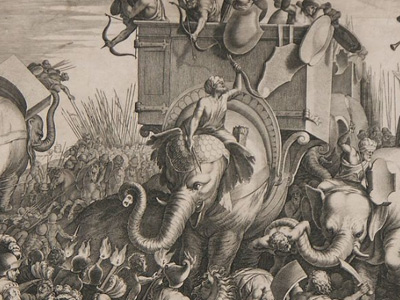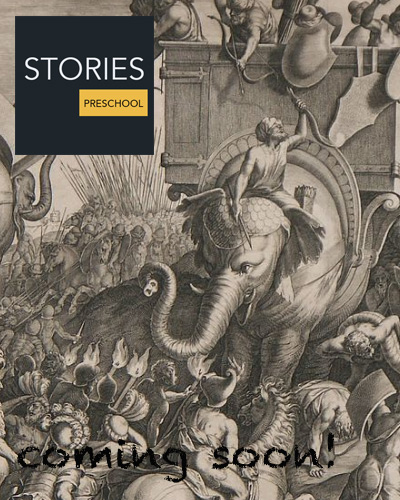Battle of Zama (202 BC)

The Battle of Zama—fought in 202 BC near Zama (Tunisia)—marked the end of the Second Punic War. A Roman army led by Publius Cornelius Scipio Africanus (Scipio), with crucial support from Numidian leader Masinissa, defeated the Carthaginian army led by the commander Hannibal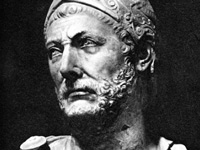 Hannibal Barca (247-183 BC), was a Carthaginian general, considered one of the greatest military commanders in history. Hannibal lived during a period of great tension in the western Mediterranean Basin, when the Roman Republic established its supremacy over other great powers such as ancient Carthage. One of his most famous achievements was at the outbreak of the Second Punic War, when he marched an army which included war elephants from Iberia over the Pyrenees and the Alps into Italy. Hannibal Barca ». Hannibal's force was greater in numbers than Scipio's, and he had eighty war elephants. However, many in Hannibal's army were recent conscripts, and the Romans had superior cavalry, as most of the vaunted Numidian cavalry which Hannibal had employed with great success in Italy had by then switched sides to the Romans
Hannibal Barca (247-183 BC), was a Carthaginian general, considered one of the greatest military commanders in history. Hannibal lived during a period of great tension in the western Mediterranean Basin, when the Roman Republic established its supremacy over other great powers such as ancient Carthage. One of his most famous achievements was at the outbreak of the Second Punic War, when he marched an army which included war elephants from Iberia over the Pyrenees and the Alps into Italy. Hannibal Barca ». Hannibal's force was greater in numbers than Scipio's, and he had eighty war elephants. However, many in Hannibal's army were recent conscripts, and the Romans had superior cavalry, as most of the vaunted Numidian cavalry which Hannibal had employed with great success in Italy had by then switched sides to the Romans The Roman Republic was a form of government of Rome and the era of the classical Roman civilization when it was run through public representation of the Roman people. Beginning with the overthrow of the Roman Kingdom (traditionally dated to 509 BC) and ending in 27 BC with the establishment of the Roman Empire, Rome's control rapidly expanded during this period - from the city's immediate surroundings to hegemony over the entire Mediterranean world..
The Roman Republic was a form of government of Rome and the era of the classical Roman civilization when it was run through public representation of the Roman people. Beginning with the overthrow of the Roman Kingdom (traditionally dated to 509 BC) and ending in 27 BC with the establishment of the Roman Empire, Rome's control rapidly expanded during this period - from the city's immediate surroundings to hegemony over the entire Mediterranean world..
Scipio's troops did not mass together to oppose the elephants, but instead blew their horns loudly, opened their ranks to let the elephants charge through, and pelted the elephants with missiles, confusing and defeating them. His main force then routed the Carthaginian infantry, assisted by the cavalry who had pursued the Carthaginian cavalry off the field and returned to attack the infantry force. Defeated on their home ground, the Carthaginian ruling elite sued for peace and accepted humiliating terms, ending the 17-year war.
Prelude
Crossing the Alps, Hannibal reached the Italian peninsula in 218 BC and won several major victories against the Roman armies. The Romans failed to defeat Hannibal or drive him from Italy, but following Scipio's decisive victory at the Battle of Ilipa in Spain in 206 BC, Iberia had been secured by the Romans. In 205 BC, Scipio returned to Rome, where he was elected consul with a unanimous vote. Scipio, now powerful enough, proposed to end the war by directly invading the Carthaginian home land. The Senate initially opposed this ambitious design of Scipio, persuaded by Quintus Fabius Maximus that the enterprise was far too hazardous. However, Scipio and his supporters eventually convinced the Senate to ratify the plan, and Scipio was given the requisite authority to attempt the invasion.
Initially Scipio received no levy troops, and he sailed to Sicily with a group of 7,000 heterogeneous volunteers. He was later authorised also to employ the regulars stationed in Sicily, who consisted mainly of the remnants of the 5th and 6th Legion, exiled to the island as a punishment for the humiliation they suffered at the Battle of Cannae.
Scipio continued to reinforce his troops with local defectors. He landed at Utica, and defeated the Carthaginian army at the Battle of the Great Plains in 203 BC. The panicked Carthaginians felt that they had no alternative but to offer peace to Scipio, and Scipio, who had the authority to do so, granted peace on generous terms. Under the treaty, Carthage could keep its African territory, but would lose its overseas empire, by that time a fait-accompli. Masinissa was to be allowed to expand Numidia into parts of Africa. Also, Carthage was to reduce its fleet and pay a war indemnity. The Roman senate ratified the treaty. The Carthaginian senate recalled Hannibal, who was still in Italy (although confined to the south of the peninsula) when Scipio landed in Africa, in 203 BC. Meanwhile, the Carthaginians breached the armistice agreement by capturing a stranded Roman fleet in the Gulf of Tunis and stripping it of supplies. The Carthaginians no longer believed a treaty advantageous, and rebuffed it under much Roman protest.
Troop Deployment
Hannibal led an army composed of mercenaries, local citizens, and veterans and Numidian cavalry from his Italian campaigns. Scipio led a pre-Marian Roman army quincunx, along with a body of Numidian cavalry.
The battle took place at Zama Regia, near Siliana 130 km south-west of the capital Tunis. Hannibal was first to march and reach the plains of Zama Regia, which were suitable for cavalry maneuvering. This also gave an upper edge in turn to Scipio who relied heavily on his Roman heavy cavalry and Numidian light cavalry. Hannibal deployed his troops facing northwest, while Scipio deployed his troops in front of the Carthaginian army facing southeast.
Hannibal's army consisted of 36,000 infantry, 4,000 cavalry, and 80 war elephants, while Scipio had a total of 29,000 infantry and 6,100 cavalry. Putting his cavalry on the flanks, with the inexperienced Carthaginian cavalry on the right, and the Numidians on the left, Hannibal aligned the rest of his troops in three straight lines behind his elephants. The first line consisted of mixed infantry of mercenaries from Gaul, Liguria, and the Balearic Islands. In his second line he placed the Carthaginian and Libyan citizen levies, while his veterans from Italy were placed in the third line. Hannibal intentionally held back his third infantry line, in order to thwart Scipio's tendency to pin the Carthaginian center and envelop his opponent's lines, as he had previously done at the Battle of Ilipa. Livy states that Hannibal deployed 4,000 Macedonians in the second line. Their presence is widely discounted as Roman propaganda, although T. Dorey suggests that there may be a grain of truth here if the Carthaginians recruited a trivial and unofficial number of mercenaries from Macedonia.
Scipio deployed his army in three lines: the first line was composed of the hastati, the second line of principes and the third line of the triarii. The stronger right wing was composed of the Numidian cavalry and commanded by Masinissa, while the left wing was composed of the Italian cavalry under the command of Laelius. The greatest concern for Scipio was the elephants. He came up with an ingenious plan to deal with them.
Scipio knew that elephants could be ordered to charge forward, but they could only continue their charge in a straight line. Scipio predicted that if he opened gaps in his troops, the elephants would simply pass between them, without harming any of his soldiers. Scipio created the lanes between the army regiments across the depth of his troops and hid them with maniples of skirmishers. The plan was that when the elephants charged, these lanes would open, allowing them to pass through the legionaries' ranks and be dealt with at the rear of the army.
Hannibal and the Carthaginians had relied on cavalry superiority in previous battles such as Cannae, but Scipio, recognizing their importance, held the cavalry advantage at Zama. This was due in part to his raising of a new cavalry regiment in Sicily and careful courting of Masinissa as an ally.
Hannibal most likely believed that the combination of the war elephants and the depth of the first two lines would weaken and disorganize the Roman advance. This would have allowed him to complete a victory with his reserves in the third line and overlap Scipio's lines. Though this formation was well-conceived, it failed to produce a Carthaginian victory. The two men are said to have met face-to-face before the battle. Hannibal offered a treaty that would give up any claims to overseas territories, only to ensure the sovereignty of Carthage. Scipio refused, saying that it was either unconditional surrender or battle.
Battle
At the outset of the battle, Hannibal unleashed his elephants and skirmishers against the Roman troops in order to break the cohesion of their lines and exploit the breaches that could be opened. The attack was confronted by the Roman skirmishers. In addition, Scipio ordered the cavalry to blow loud horns to frighten the beasts, which partly succeeded, and several rampaging elephants turned towards the Carthaginian left wing and disordered it completely. Seizing this opportunity, Masinissa led his Numidian cavalry and charged at the Carthaginian left wing, which was also composed of Numidian cavalry, and was unknowingly lured off the field. Meanwhile, the rest of the elephants were carefully lured through the lanes and taken to the rear of the Roman army, where they were dealt with. Scipio's plan to neutralize the threat of the elephants had worked. Scipio's troops then fell back into traditional Roman battle formation. Laelius, the commander of the Roman left wing, charged against the Carthaginian right. The Carthaginian cavalry, acting on the instructions of Hannibal, allowed the Roman cavalry to chase them so as to lure them away from the battlefield so that they wouldn't attack the Carthaginian armies in the rear.
Scipio now marched with his center towards the Carthaginian center, which was under the direct command of Hannibal. Hannibal moved forward with only two lines and the third line of veterans was kept in reserve. After a close contest, the first line of Hannibal was pushed back by the Roman hastati. Hannibal ordered his second line not to allow the first line in their ranks. The bulk of them managed to escape and to position themselves on the wings of the second line on Hannibal's instructions. Hannibal now charged with his second line. A furious struggle ensued and the Roman hastati were pushed back with heavy losses. Scipio reinforced the hastati with the second line principes.
With this reinforcement the Roman front renewed their attack and defeated Hannibal's second line. Again, the second line was not allowed to merge with the third line and was forced to the wings along with the first line. Carthaginian cavalry carried out Hannibal's instructions well and there was no sign of Roman cavalry on the battlefield. Once they were far enough away, they turned and attacked the Roman cavalry but were routed in the end. At this point there was a pause in the battle as both sides redeployed their troops. Scipio played for time as he redeployed his troops in a single line with the hastati in the middle and the principes in the inner wings and the triarii on the outer wings. Hannibal waited for Scipio to attack. The resulting clash was fierce and bloody, with neither side achieving local superiority. However, Scipio was able to rally his men. The battle finally turned in the Roman's favor as the Roman cavalry returned to the battlefield and attacked the Carthaginian line from behind. The Carthaginian infantry was encircled and annihilated. Thousands of Carthaginians, including Hannibal, managed to escape the slaughter. Hannibal experienced a major defeat that put an end to all resistance on the part of Carthage. In total, as many as 20,000 men of Hannibal’s army were killed at Zama, while 20,000 were taken as prisoners. The Romans, on the other hand, suffered as few as 2,500 dead.
Aftermath
Soon after Scipio's victory at Zama, the war ended with the Carthaginian senate suing for peace. Unlike the treaty that ended the First Punic War, the terms Carthage acceded to were so punishing that it was never able to challenge Rome for supremacy of the Mediterranean again. The treaty bankrupted Carthage and destroyed any chance of its being a military power in the future, although its economic recovery was quick. One provision of the treaty was that the Carthaginians were not allowed to make war without Roman consent. This allowed the Romans to establish a casus belli for the Third Punic War when the Carthaginians defended themselves from Numidian encroachments in which the Romans did not intervene.
When Rome waged war again on Carthage about 50 years later, the Carthaginians had little power and could not defeat the by-then very aged Masinissa in Africa. They did, however, organize a defense of their home city, which, after an extended siege, was captured and completely destroyed in 146 BC. Only 55,000 survived.
HISTORY
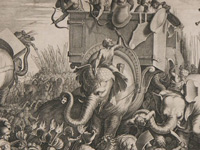
RESOURCES
This article uses material from the Wikipedia article "Battle of Zama (202 BC)", which is released under the Creative Commons Attribution-Share-Alike License 3.0.
© Stories Preschool. All Rights Reserved.
